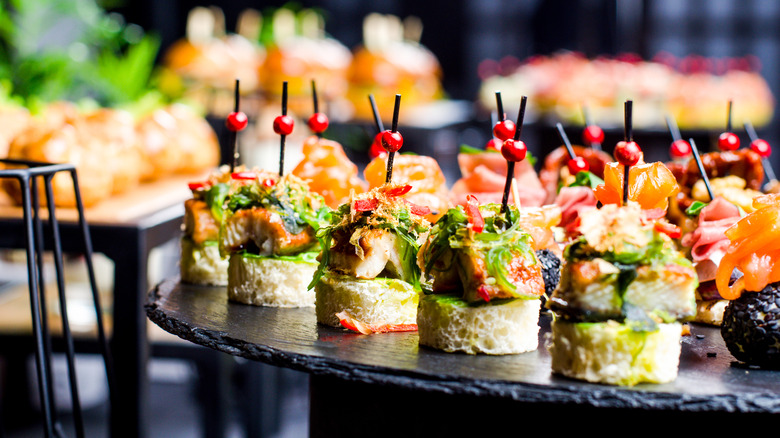Canapés Were Actually Named After Furniture. Here's Why
Canapé. Just the word itself evokes thoughts of hoity-toity cocktail parties, a glass of champagne in one hand, a plate of tiny, pretty food in the other. Canapés have become equated with fanciness. But in reality, a canapé is just finger food, an hors d'oeuvre, an appetizer. What sets a canapé apart, according to Merriam-Webster, is bread. The online dictionary defines an hors d'oeuvre as any savory food served as an appetizer. But a canapé, although an appetizer as well, must be a piece of bread, pastry or cracker topped with something savory. With this in mind, some of our favorite finger foods like deviled eggs, mozzarella sticks, and sweet and sour meatballs can be deemed as hors d'oeuvres while bruschetta, cheddar on Ritz, and hummus on pita chips qualify as canapés. Hardly fancy food at all.
Still, throwing a party and serving "canapés" sounds so much more appealing than hosting a finger food party, no doubt because the word is French, the language of the land of chicness. This elegant word is surely reminiscent of a beautiful flower, or a person of royalty, right? Sure, if you consider furniture refined.
Have a seat
Canapé is the French word for "couch." The living room sofa. The sectional. Food blog The Canape Kitchen, suggests that, while the term is all-encompassing of any type of couch, it best describes something stylish and sophisticated, like a settee or maybe a Chesterfield. Perhaps this is because people tend to eat their canapés in the living room while chatting as opposed to eating a meal at the dining room table. Not really. According to PBS, the term came about in France in the late 18th century when someone (probably an upper crust family's house chef) sat their traditional hors d'oeuvre on top of a piece of bread. The creation was reminiscent of a person sitting on a couch.
Today the term canapé is used for any bite-sized food served at parties and events. Sometimes it involves a cracker, toast, or piece of bread, and other times it does not. For the most part, though, canapes are attractive and delicious-looking. They tend to take time to assemble but that's because they are served to guests who the host wants to make feel special. While the ingredients certainly don't have to be fancy and expensive, the overall result should be something beautiful to behold.

